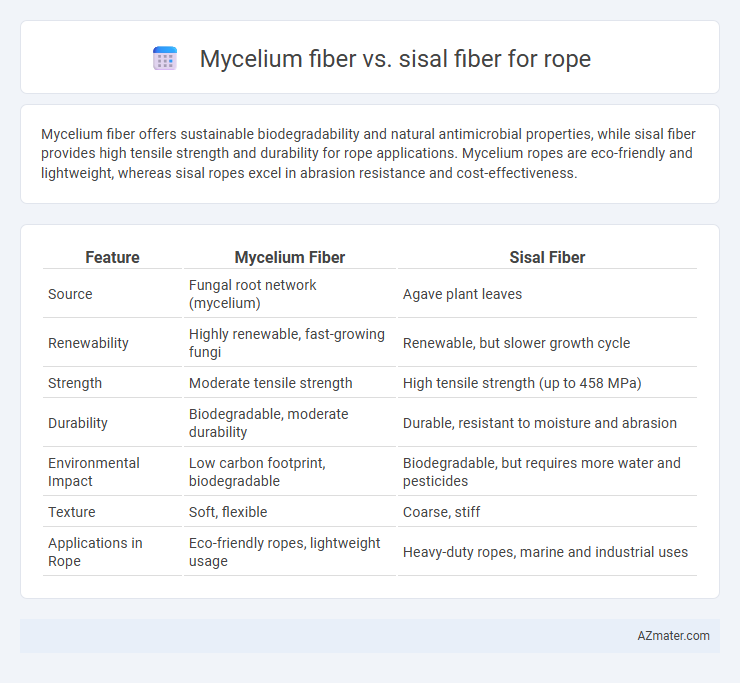Mycelium fiber offers sustainable biodegradability and natural antimicrobial properties, while sisal fiber provides high tensile strength and durability for rope applications. Mycelium ropes are eco-friendly and lightweight, whereas sisal ropes excel in abrasion resistance and cost-effectiveness.
Table of Comparison
| Feature | Mycelium Fiber | Sisal Fiber |
|---|---|---|
| Source | Fungal root network (mycelium) | Agave plant leaves |
| Renewability | Highly renewable, fast-growing fungi | Renewable, but slower growth cycle |
| Strength | Moderate tensile strength | High tensile strength (up to 458 MPa) |
| Durability | Biodegradable, moderate durability | Durable, resistant to moisture and abrasion |
| Environmental Impact | Low carbon footprint, biodegradable | Biodegradable, but requires more water and pesticides |
| Texture | Soft, flexible | Coarse, stiff |
| Applications in Rope | Eco-friendly ropes, lightweight usage | Heavy-duty ropes, marine and industrial uses |
Introduction to Natural Fibers in Rope Manufacturing
Mycelium fiber and sisal fiber represent two emerging natural materials in rope manufacturing, each offering unique properties for sustainable applications. Mycelium fiber, derived from fungal mycelium, provides lightweight, biodegradable, and flexible characteristics, ideal for eco-friendly ropes with enhanced durability. Sisal fiber, extracted from the Agave sisalana plant, delivers strong, coarse, and abrasion-resistant qualities traditionally favored in heavy-duty rope production.
What is Mycelium Fiber?
Mycelium fiber is derived from the root-like structure of fungi, offering a sustainable and biodegradable alternative to traditional plant-based fibers like sisal. Unlike sisal, which is extracted from the Agave plant and known for its coarse texture and high tensile strength, mycelium fiber provides flexibility, lightweight properties, and natural resistance to moisture and microbial growth. This innovative biomaterial is gaining attention in the rope industry for its eco-friendly production methods and potential to reduce environmental impact compared to conventional fibers.
What is Sisal Fiber?
Sisal fiber, derived from the leaves of the Agave sisalana plant, is a natural fiber known for its strength, durability, and resistance to moisture, making it ideal for rope manufacturing. Unlike mycelium fiber, which is fungal-based and biodegradable, sisal fiber is highly coarse and best suited for heavy-duty ropes used in agriculture, shipping, and construction. Sisal's natural rigidity and resistance to wear ensure superior performance in harsh environments compared to emerging alternatives like mycelium fiber.
Comparing Mycelium and Sisal: Physical Properties
Mycelium fiber exhibits a lightweight structure with high elasticity and biodegradability, offering superior flexibility compared to sisal fiber, which is coarser, stiffer, and more rigid due to its cellulose-rich composition. Sisal fiber provides greater tensile strength and durability, making it ideal for heavy-duty rope applications, whereas mycelium fiber excels in applications requiring eco-friendly, lightweight, and pliable materials. Moisture resistance in sisal fiber is moderate but less than synthetic fibers, while mycelium fiber naturally resists microbial degradation, enhancing its longevity under humid conditions.
Strength and Durability: Mycelium vs Sisal Ropes
Mycelium fiber ropes exhibit impressive tensile strength due to their densely packed hyphal structure, often surpassing traditional natural fibers like sisal. Sisal ropes are known for their moderate strength and good abrasion resistance but tend to degrade faster when exposed to moisture and UV light. In contrast, mycelium ropes offer enhanced durability with greater resistance to environmental factors, making them a superior choice for long-lasting, high-strength rope applications.
Environmental Impact and Sustainability
Mycelium fiber offers a superior environmental profile compared to sisal fiber, as it is derived from fungal networks that grow rapidly with minimal water and land use, reducing deforestation and habitat disruption. Sisal fiber, sourced from Agave plants, requires significant agricultural inputs and can contribute to soil degradation and water consumption in arid regions. The biodegradability and carbon sequestration potential of mycelium fiber further enhance its sustainability, positioning it as a more eco-friendly alternative for rope production.
Production Costs and Scalability
Mycelium fiber production has lower initial costs due to its rapid growth and use of agricultural waste, whereas sisal fiber requires extensive cultivation and labor-intensive harvesting, leading to higher production expenses. Scalability favors mycelium fiber as it can be grown in controlled environments year-round without dependence on arable land, while sisal fiber scalability is limited by climatic conditions and long maturation cycles. The faster production cycle and potential for industrial automation make mycelium fiber a more cost-effective and scalable option for rope manufacturing compared to traditional sisal fiber.
Biodegradability and End-of-Life Considerations
Mycelium fiber exhibits superior biodegradability compared to sisal fiber, breaking down more rapidly and naturally in soil without releasing harmful residues. Sisal fiber, while biodegradable, decomposes at a slower rate and can persist longer in the environment, impacting end-of-life disposal strategies. Choosing mycelium fiber for rope production enhances sustainability by enabling faster composting and reducing landfill accumulation.
Applications and Industry Use Cases
Mycelium fiber offers biodegradable, sustainable alternatives ideal for eco-friendly packaging, insulation, and lightweight composite materials, making it highly suitable for green construction and automotive industries. Sisal fiber is prized in marine, agricultural, and home decor sectors due to its high tensile strength, durability, and resistance to moisture, commonly used in ropes, mats, and brushes. Both fibers serve diverse industry needs, with mycelium favored for innovative sustainability-driven products and sisal excelling in traditional, heavy-duty applications.
Future Trends in Eco-Friendly Rope Materials
Mycelium fiber and sisal fiber represent promising eco-friendly alternatives for rope manufacturing due to their biodegradability and sustainability. Mycelium fiber, derived from fungal networks, offers enhanced strength and faster growth cycles compared to traditional sisal, which is harvested from agave leaves and valued for its natural durability and pest resistance. Future trends emphasize integrating mycelium's rapid renewability with sisal's proven mechanical properties to develop hybrid ropes that reduce environmental impact while maintaining high performance.

Infographic: Mycelium fiber vs Sisal fiber for Rope
 azmater.com
azmater.com